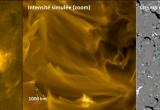The Solar Orbiter mission yields many first scientific results
For a mission that has just entered its scientific exploitation phase, Solar Orbiter has already produced many remarkable results. A recent special issue of Astronomy and Astrophysics brings together a multitude of studies and observations obtained during the mission's cruise phase. No less than 56 papers have been published, each containing data produced by one or several Solar Orbiter instruments, in which many laboratories including IAS have been strongly involved.
After a launch in February 2020 and a 21-month journey of nearly two billion kilometers, the probe used the Earth's gravitational assistance one last time on November 27, marking the end of its cruise phase and the beginning of its scientific exploitation phase. During the cruise phase, mainly used to start up, test and calibrate the ten instruments of the probe (remote sensing and in-situ measurement instruments), the data collected were of such a quality that they have already allowed several scientific studies to be undertaken.
The scientific exploitation phase that has just started is therefore promising. It will be marked at the end of March 2022 by a first perihelion (closest passage to the Sun) at 0.3 astronomical units, which is about the minimum distance of Mercury to the Sun.
IAS is strongly involved in three of the Solar Orbiter instruments: PHI (Polarimetric and Helioseismic Imager), EUI (Extreme Ultraviolet Imager), and SPICE (SPectral Imaging of the Coronal Environment). The IAS is co-Principal Investigator for EUI, and Principal Investigator for SPICE.
The first observations of EUI immediately provided some of the finest images of the solar corona ever obtained. These images revealed bright structures at very small scales (400 km for the smallest) that could be the signature of the 'nano-eruptions' imagined by Eugene Parker more than 20 years ago to solve solar coronal heating problem: how to explain that the atmosphere of our star has a temperature of more than a million degrees while its surface is only at 5000 degrees? The main characteristics of the events observed by EUI are in good agreement with magnetohydrodynamics (MHD) models. However, these high-resolution observations obtained during the in-flight commisionning phase lasted only 5 minutes and do not allow the statistical study necessary to establish whether the nano-eruptions alone can maintain the coronal temperature at a high level. Dedicated observations are therefore planned for the next perihelion, during which the spatial resolution will be more than twice as good.
The SPICE spectrograph was designed to provide maps of the chemical composition of the Sun's atmosphere, in order to identify the sources of the solar wind by comparison with in situ composition measurements. SPICE observations during the flight acceptance phase identified bright spots of unusual intensity and duration. It is possible that there is a link between these structures and those observed by EUI (see above). Again, observations of the first perihelion of the Solar Orbiter science operations phase are highly anticipated.

First very high resolution observations of EUI (resolution: 400 km on the Sun) showing the small events called 'campfires'. MHD numerical simulations (center) indicate that these can be the signature of energy dissipation during the reconnection of magnetic field lines (right). Adapted from Chen et al (2021). © EUI/ROB/IAS/LCFIO/MPS/PMOD/UCL
Links:
- Astronomy & Astrophysics special issue
- INSU news item
- Solar Orbiter on the ESA website
- Where is Solar Orbiter ?
Contact at IAS : Frédéric Auchère




